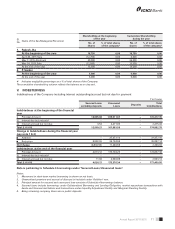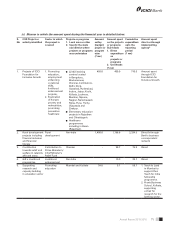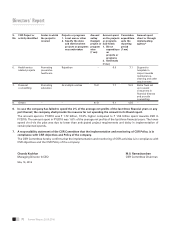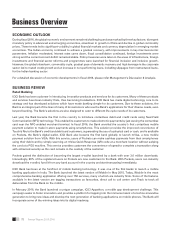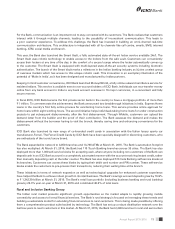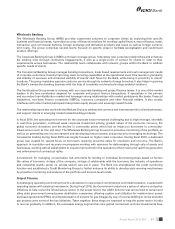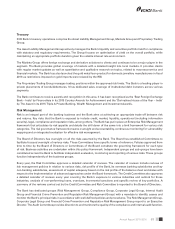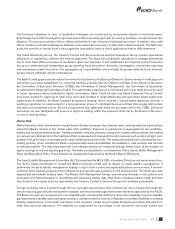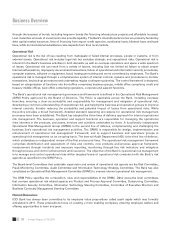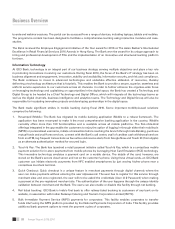ICICI Bank 2016 Annual Report Download - page 83
Download and view the complete annual report
Please find page 83 of the 2016 ICICI Bank annual report below. You can navigate through the pages in the report by either clicking on the pages listed below, or by using the keyword search tool below to find specific information within the annual report.
81Annual Report 2015-2016
Wholesale Banking
The Wholesale Banking Group (WBG) provides customised solutions to corporate clients by analysing their specic
business and nancial needs. It provides an array of nancial solutions for working capital nance, export nance, trade,
transaction and commercial banking, foreign exchange and derivative products and rupee as well as foreign currency
term loans. The group comprises several teams focused on specic areas to facilitate specialisation and customised
product offerings.
The Corporate Banking Group is WBG’s principal coverage group. It develops new corporate relationships and enhances
the existing ones through continuous engagements. It acts as a single point of contact for clients to cater to their
requirements across businesses. The relationship team collaborates with relevant groups within the Bank to address
specic needs of clients.
The Commercial Banking Group manages banking transactions, trade based requirements and cash management needs
of corporate customers, thereby improving client servicing capabilities at the operational level. This results in granularity
and stability of revenues and enhanced visibility of clients’ cash ows for the Bank, while being in proximity to clients’
locations. The group maintains superior customer service through its network of mega branches. It also helps in growing
the Bank’s transaction banking business with the help of constantly evolving technology-enabled solutions.
The Syndications Group works in synergy with our corporate banking and project nance teams. It is one of the market
leaders in the loan syndication segment for corporate and project nance transactions. It specialises in the primary
and secondary loan distribution market and leverages strong relationships with market participants like banks, nancial
institutions, non-bank nance companies (NBFCs), insurance companies and other nancial entities. It also closely
interfaces with other market participants like private equity players and sovereign wealth funds.
The relationship teams also work with the Markets Group to address the currency and interest rate risk in client businesses;
and support clients in arranging market related funding products.
In scal 2016, the operating environment for the corporate sector remained challenging due to high leverage, shortfalls
in cash ow generation, continued weak corporate investment activity, gradual nature of the economic recovery, the
global economic slowdown and the decline in commodity prices which had an impact on borrowers in commodity-
linked sectors such as iron and steel. The Wholesale Banking Group focused on proactive monitoring of the portfolio, as
well as on generating new income streams and developing new processes and products by leveraging technology. The
incremental lending during scal 2016 was largely focused on higher rated corporates. During scal 2016, a dedicated
group was created for special focus on borrowers requiring proactive steps for resolution and recovery. The Bank’s
approach to resolution and recovery encompasses working with sponsors for deleveraging through sale of assets and
businesses, working with all stakeholders to ensure improvement in the operations of borrowers and cash ow generation
and enforcement of contractual rights.
A framework for managing concentration risk with limits for lending to individual borrowers/groups based on factors
like rating of borrower, vintage of the company, vintage of relationship with the borrower, the industry of operations
and ownership (public sector vs. private sector) was put in place. The Bank has strengthened the credit monitoring
function and established a Credit Monitoring Group to further enhance its ability to develop early warning mechanisms
by proactive monitoring and analysis of the portfolio and account-level trends.
Project Finance
A challenging operating environment led to a slowdown in new project commitments and implementation, coupled with
operating issues with existing investments. During scal 2016, the Government undertook a series of reforms and policy
initiatives to help revive the infrastructure sector. In the power sector, the UDAY Scheme was announced to turnaround
ailing state government owned power distribution companies; allowing captive coal utilization for medium-term power
purchase agreements (PPAs) and implementation of scheme for gas linkages by way of reverse bidding to revive stranded
gas projects were some of the key initiatives. Taken together, these steps are expected to help the power sector in India
to recover gradually. In addition, the renewable energy segment has also gained momentum and new investments have


